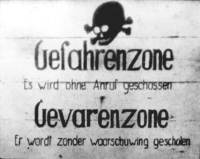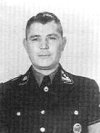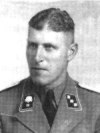Westerbork
 |
| Camp Map |
The town of Westerbork is situated in the northeast of the Netherlands in the
province of Drenthe, about 130 km (80 miles) north of
Amsterdam. In a
resolution proposed by the Minister of Home Affairs and approved by the
Dutch cabinet on
13 February 1939, it was determined to construct a camp
"to house the refugees from Germany that live in this country". Opened on
9 October 1939, the costs of constructing the camp, amounting to 1.25 million
gulden, were charged to the Jewish Refugee Committee in the Netherlands.
When the Germans invaded the Netherlands in
May 1940, there were 750
refugees resident in the camp. Initially moved to
Leeuwarden, they were moved
back to Westerbork following the Dutch surrender. The camp came under the
control of the Ministry of Justice on
16 July 1940. Refugees from other camps
were subsequently moved to Westerbork, which by
1941 had a population of
1,100 in 200 small wooden houses. In the words of one commentator, it was a
site "about as inhospitable as could be, far from the civilized world in the
isolation of the Drenthe moorland, difficult to reach, with unpaved roads where
even the slightest shower would turn the sand to mud." The camp was also
plagued by hosts of flies during the summer months.
 |
| Watchtower * |
 |
| Warning Sign |
At the
end of 1941, the Germans decided that Westerbork would become
a transit camp for Jews destined to be deported to the east. Measuring
500x500 m, the camp was surrounded by a barbed-wire fence. 24 large
wooden barracks were constructed. Eventually there were to be 107 such
barracks, each designed to hold 300 people. The costs of this building work
and of the camp's maintenance were to be financed from the proceeds of
confiscated Jewish property, an amount that was to exceed 10 million gulden
for
1942/43. During the first six months of
1942, 400 German
Jews were transferred to Westerbork from cities in the Netherlands from which Dutch
Jews had been evicted to
Amsterdam.
 |
| Gemmeker |
On
1 July 1942, the
Befehlshaber der
Sicherheitspolizei und des SD took control of the camp, and SS troops arrived
to reinforce the Dutch military police guards.
Erich Deppner, a member of the
German administration in the Netherlands was appointed camp commandant,
to be succeeded by an SS officer,
Josef Hugo Dischner on
1 September 1942.
Both men having proved to be equally incompetent,
Albert Konrad Gemmeker
became commandant on
12 October 1942.
Gemmeker
left the day-to day
operation of the camp in the hands of German Jews, as had been the case from
inception, an arrangement which was not to change even when the majority of the
inmates were Dutch. The inmates rarely saw members of the SS other than
Gemmeker. On
13 July 1942, most of the
people who had lived in the camp, many of them for as long as two years, were dismissed from the
camp administration. Those dismissed included virtually everybody who was not deemed purely Jewish by
Nazi criteria. One day later all inmates born
between 1902 and 1925 were examined
on behalf of the
Arbeitseinsatz (Work Allocation Department).
Deppner explained: "Your labour is also needed for our victory."
 |
| Gemmeker's House in 2006 |
The transfer of Jews from
Amsterdam to Westerbork began on the night of
14/15 July 1942, and the first transport left for
Auschwitz on the following day. In addition, on
15 July the
Dutch railroad company
Nederlandse Spoorwegen received an order for the construction
of a 5 km railroad into Camp Westerbork. The timetable for the trains, their size and
destination were determined by
Adolf Eichmann's lVB4 office.
Gemmeker left the
composition of the transports to the Jewish camp leadership (
Kampleiding). However,
certain inmates, such as those of foreign nationality or veteran servicemen were exempt
from transportation. Beginning on
2 February 1943, deportation trains left Westerbork on
Tuesdays, although there were periods in which no deportations took place. Initially transports
were in cattle wagons, although passenger cars were later also utilised.
Unlike other transit camps, Westerbork maintained a semi-permanent population who
remained in the camp for a considerable time, ran their own affairs and maintained a
near-normal life, especially in the periods when there were no deportations.
Elie Cohen, a doctor, was in Westerbork for 8 months before being sent to
Auschwitz. Whilst never
pleasant, conditions in the camp were far more bearable than in the transit camps in the
east, although the water supply was bad, and washing and sanitary facilities were inadequate.
The great majority of those who passed through the camp only stayed for a week or two before
boarding eastward bound trains, despite the
Kampleiding's attempts to save people from
deportation by providing them with jobs within the camp. For example, prisoners were
enrolled in the
Ordedienst, or in the
Fliegende Kolonne, a section who were responsible for
ensuring the transfer of deportees to the railway station in the nearby village of
Hooghalen, used before the railroad into the camp became operational.
Those Jews who had been caught in hiding within Holland were labelled "Convict Jews" and
were placed in a punishment block, Barrack 67. Unlike other inmates, they were not allowed
to keep their own clothes, but were forced to wear blue overalls and wooden clogs. Men
and women in the punishment block had their hair shaved, received no soap, less food than
other prisoners and were forced to work in the most arduous labour details.
 |
| Arrival at Westerbork * |
 |
| Departure from Westerbork * |
The camp administration consisted of twelve subdivisions. On
12 August 1943, one of the
subdivision heads,
Kurt Schlesinger, was appointed chief of the department
dealing with the vital main card index, from which the list of deportees was compiled. A
Joodsche
Ordedienst (Jewish Police Force), commanded by an Austrian,
Arthur Pisk, was also
created, with a maximum strength of 200 young men responsible for maintaining order
within the camp and at the transports. Westerbork took on many of the characteristics of a
small town. There was a hospital headed by
Dr F M Spanier, with 1,800 beds,
a maternity ward, laboratories, pharmacies, 120 doctors and a further 1,000 employees. Other facilities
included an old people's home, a huge modern kitchen, a school for children aged 6-14, an
orphanage and religious services. Workshops existed for stocking repair, tailoring, furniture
manufacturing, and bookbinding. There were divisions for locksmiths, decorators, bricklayers,
carpenters, veterinarians, opticians and gardeners. The camp included an electro-technical
division, a garage and boiler room, a sewage works, and a telephone exchange. In 1943,
when the "permanent" population was at its peak, 6,035 people were employed at the camp,
not all of whom were Jewish.
Although men and women were segregated at night, there was no restriction on their
movements during the day. Services within the camp included dental clinics, hairdressers,
photographers and a postal system. Various sporting activities were available, including
boxing, tug-of-war and gymnastics.
Gemmeker encouraged entertainment
activities – there was a cabaret, a choir and a ballet troupe. Toiletries, toys and plants could be purchased
from the camp warehouse. There were no shortages in the camp, since it was regularly
supplied by the Dutch administration and
Gemmeker had a fund at his disposal
appropriated from the Jewish property that had been confiscated.
In case it should be thought that this was an idyllic existence, it should be born in mind that
every inmate had the spectre of imminent death hanging over them. The railway line into the
camp had been completed in
November 1942 and allowed trains into the centre of the
compound. 101,525 of the 107,000 Dutch Jews deported to the east were interned at
Westerbork – 41,156 men, 45,867 women and 14,502 children. More than 95% of those
deported from the camp perished.
 |
| Postcard from 1943 |
Fear of death dominated Westerbork and defined the behaviour of many of its inmates.
Although no detailed knowledge about the destination of the transports was known, the
prisoners were only too aware that the Germans were not planning anything that would
prove to the deportees benefit. In order to keep their names off the
transport lists, people
would do anything – "sacrifice their last hoarded halfpenny, their jewels, their clothes, their
food, or in the case of young girls, their bodies."
As each Tuesday approached, every inmate had to endure the trauma of possible deportation. A single example
of the horrific nature of these transports will suffice. An eyewitness,
Philip Mechanicus, a renowned journalist and author of a camp diary, recorded
on
10 June 1943:
"
About fifty children who were on the transports from
Vught have been admitted, dispersed in the isolation
barracks for the ill. They suffer from scarlet fever, measles, pneumonia, and mumps."
On
8 February 1944, a transport of more than 1,000 Jews was deported
from Westerbork to
Auschwitz-Birkenau. Among them were
268 of the camp's hospital patients, including children with scarlet fever and diphtheria.
Many of the sick were brought to the train on stretchers. On arrival at
Auschwitz-Birkenau , 142 men and 73 women were
admitted to the camp. The remaining 800 deportees, including all of the children, were gassed.
Mechanicus wrote:
"
Of all these bestial transports, perhaps this was the most fiendish."
Many of the sick were brought to the train on stretchers. On arrival at
Auschwitz-Birkenau, 142 men and 73 women were
admitted to the camp. The remaining 800 deportees, including all of the children, were gassed.
The final transport from the Netherlands to
Auschwitz
was on
3 September 1944.
Two days later the camp was crowded with members of the NSB (Dutch Nazi Party), who tried to flee
to Germany after false rumours of an invasion of the country by Allied forces ("Mad Tuesday").
The last transport to
Bergen-Belsen left on
15 September 1944. After this deportation, less than 1,000
inmates remained in
Westerbork.
Gemmeker remained an enigmatic figure. He rarely raised his voice
or dealt out punishments to the prisoners, and was said to be incorruptible. He took an interest in the camp's
entertainments and afterwards joked with the performers. Jewish gardeners cultivated
flowers for him and he was treated by Jewish doctors and dentists. Yet on Tuesdays he
stood quietly watching the trains depart for the east.
Gemmeker had a film made in
Westerbork which was to show everything, good and bad, of the camp's daily life. Scenes from the film appear frequently
in Shoah-related documentaries. One particularly haunting image from the film, that of a 9 year-old girl staring
from the doorway of a cattle wagon, has become synonymous with the Holocaust. The girl, who was in fact not Jewish,
but Roma, was named
Settela Steinbach. She perished in
Auschwitz-Birkenau.
On
12 April 1945, as allied forces approached Westerbork,
Gemmeker handed the camp
over to
Schlesinger. On that day, there were 876 prisoners in the camp,
of whom 569 were Dutch. The remainder were of various nationalities, or stateless.
Gemmeker was sentenced
to 10 years imprisonment by a post-war Dutch court. Extenuating circumstances were taken
into account in arriving at the sentence, in that "in general he had treated Jews decently
during their stay in the camp."
As with some other transit camps, Westerbork had its own
currency.
See
Westerbork today!
Vught
 |
| Camp Map |
 |
| Chmielewski |
Originally established as a
Schutzhaftlager for Dutch political prisoners, the camp at
Vught, near the southern city of
`s Hertogenbosch, capital of the province of Noord-Brabant,
was taken over in
late 1942 by the
WVHA (Wirtschaftsverwaltungshauptamt - SS
Economic-Administrative Main Office). Now designated
KL Herzogenbusch, the camp
became part concentration camp housing political prisoners, and part transit camp for Jews.
Karl Chmielewski was appointed camp commandant.
Chmielewski had previously served
at
KL Mauthausen/Gusen, and on his appointment transferred 80
Kapos from that camp to Vught. However, in contrast to
Mauthausen, there were strict instructions to refrain from
mistreating prisoners at Vught. Experience at
Westerbork had
shown that deportations were more easily managed if cruelty was avoided.
The camp, measuring 500x200 m, consisted of 36 living and 23 working barracks.
A double barbed-wire fence with a ditch between them surrounded the camp. Watchtowers
were placed every 50 m around the perimeter. Situated outside the camp boundary
were the SS barracks, an execution area and a
Philips industrial plant.
 |
| Grünewald |
 |
| Hüttig |
The first Jewish prisoners arrived in Vught in
January 1943 and by
May 1943 their number
had grown to 8,684. There were also non-Jewish prisoners in the
Schutzhaftlager section.
Conditions in the camp were very poor, although some improvement occurred following a
visit by
David Cohen of the
Joodsche Raad. From
April 1943, a number
of male prisoners were sent to work outside the camp, although most inmates were employed
within the camp in the manufacture of clothing and furs. The most desirable workplace
was that of the
Philips company, where 1,200 prisoners were employed. The company
insisted that its Jewish workers should enjoy decent conditions, including a hot meal every
day and also not be subject to deportation. Dr
Arthur Lehmann was appointed head of
the Jewish administration in the camp in
October 1943. He did his best to care for the
prisoners and was very popular with them. For a time religious and cultural activities had
taken place and a school had functioned, but circumstances changed for the worse with the
appointment of
Chmielewski's successor,
Adam Grünewald in
October 1943.
Grünewald was removed in turn in
January 1944
because of the excessive punishments
he had meted out, and was succeeded by
Hans Hüttig.
 |
| Childrens Memorial |
A
proclamation was issued by the Vught
Kampleiding on
5 June 1943.
Two transports were to be sent to "a special children's camp". In accordance with the terms of the
proclamation, all children up to the age of 3 were to be accompanied by their mothers
and those aged between 3 and 16 by one of their parents. The "special children's camp" was
Sobibor. The first train, containing 1,750 victims, many of them unaccompanied sick
children, arrived at
Westerbork on
7 June 1943.
The second arrived a day later. 1,300 tired, filthy people were transferred, "amid snarling and shouting,
beating and pummelling" from the dirty freight cars in which they had arrived to the dirty freight cars that would
transport them to
Sobibor.
With the exception of two transports which were directed to
Auschwitz, all transports from
Vught were routed via
Westerbork. The first of these transports to
Westerbork had left at the
end of
January 1943, shortly after the transit camp at Vught had been established. The
camp's population peaked in
May 1943 but steadily declined until
3 June 1944, when the camp was liquidated. The last group to be transported from Vught,
on
3 June 1944, was made up of 517
Philips' employees, the company having
failed to save them, but even in
Auschwitz this group received preferential
treatment, being employed by
Telefunken under an agreement made between
Telefunken and
Philips. Nonetheless, most of the men in this party perished. 160 of the group survived;
two-thirds were women and 9 were children.
Today the former camp is part of the army barracks of the Dutch Royal Engineers.
Barneveld
A third transit camp was established at Barneveld in the province of Gelderland.
Between
December 1942 and September 1943, some 700 Jews were housed in a castle,
"De Schaffelaar", and in a former relief camp for unemployed people, "De Biezen."
These were mainly socially or culturally prominent Jews – academics, lawyers, artists,
and the like. The inmates led a relatively privileged existence. They were allowed to bring
their own furniture with them, were not required to perform hard labour and were adequately
supplied with rations. However, overcrowding and the resultant lack of privacy remained
a problem. The camp, commanded by a Dutch former army officer, had 6 "controleurs"
who served as guards. The staff were not paid by the government, but from a camp fund
financed by the inmates.
The camp was closed on
29 September 1943. About 680 prisoners were transferred to
Westerbork, of whom 22 managed to escape in transit. The inmates from Barneveld
continued to enjoy their privileged status in
Westerbork. None of them were transported to
Auschwitz and when deportation did occur, they were sent in a group to
Terezin (Theresienstadt).
Other Camps
There were other camps in which Jews were interned, normally prior to being transferred
to either
Westerbork or
Vught. These were situated at
Schoorl in the province of Noord-Holland,
Amersfoort in the province of Utrecht and
Ommen in the province of Overijssel. More properly
categorized as concentration rather than transit camps, they were not primarily intended for the
incarceration of Jews, although some Jews were temporarily held there. The regime at these
camps was much harsher than that of
Vught and especially that of
Westerbork.
Elie Cohen,
who was held for a time at
Amersfoort, said that "transfer from
Amersfoort to
Westerbork was like going from hell to heaven."
Photos: GFH
*
Vught camp map: Nationaal Monument Kamp Vught
Sources:
Gutman, Israel, ed.
Encyclopedia of the Holocaust, Macmillan Publishing Company, New York, 1990
Hilberg, Raul.
The Destruction of the European Jews, Yale University Press, New Haven, 2003
Gilbert, Martin.
The Holocaust – The Jewish Tragedy, William Collins Sons & Co. Limited, London, 1986
Lee, Carol Ann.
Roses from the Earth: The Biography of Anne Frank, Penguin Books, London, 2000
Gill, Anton.
The Journey Back from Hell, Grafton Books, London 1988.
Dr. J. Presser,
Ondergang, de vervolging en verdelging van het Nederlandse
Jodendom 1940-1945, Staatsuitgeverij, ‘s-Gravenhage 1965
J.C.H. Blom e.a..
Geschiedenis van de Joden in Nederland, Olympus, 1995
Dr. L. de Jong, Rijksinstituut voor Oorlogsdocumentatie.
Het Koninkrijk der Nederlanden in de Tweede
Wereldoorlog, deel 8, Gevangenen en gedeporteerden, Martinus Nijhoff, 's-Gravenhage,1978
© ARC (http://www.deathcamps.org) 2005





















